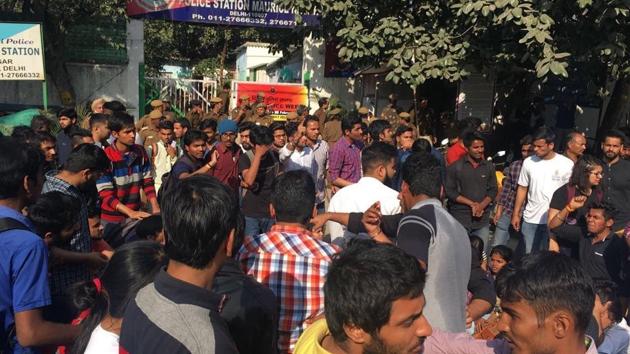Delhi Univ protests lead to ‘model’ police stations at Maurice Nagar, Parliament Street
Parliament Street and Maurice Nagar police stations will have maximum senior officials with one-third women staff. The move comes after the poor handling of the student protests by the police earlier this year.
Two important Delhi Police stations will start functioning as model police stations from Wednesday evening, equipped with senior officers and 33% women personnel in a possible bid to repair the force’s poor image following shoddy handling of campus clashes two months ago.

Parliament Street Police Station in the heart of the Capital and north Delhi’s Maurice Nagar next to Delhi University, the epicentre of protests in February, will be part of the first-of-its-kind exercise.
Lieutenant governor Anil Baijal inaugurated the initiative at Parliament Street police station – next to Delhi’s protest venue of Jantar Mantar — in the presence of police chief Amulya Patnaik and other top officers.
“The objective is to bring an attitudinal and behavioural change among police staff and change the way they work and behave with the public,” said a senior police officer.
These two stations will now have the maximum number of senior officials such as inspectors, sub-inspectors (SIs), and assistant sub-inspectors (ASIs) and lesser constabularies. A regular station currently has two or three inspectors and ten to fifteen sub-inspectors. But with this new officer- oriented policing concept, each of the two police stations will have seven inspectors, 40 sub-inspectors, 40 assistant sub-inspectors and 60 head constables.
These two will also become the first Delhi police stations where a third of the staff would be women. This means the stations would have at least two women inspectors, in addition to the male inspectors.
“The presence of more inspectors, sub-inspectors, and assistant sub-inspectors in a police station means complaints and grievances of public will be heard and addressed in a more sophisticated and professional manner,” added the officer.
The decision to turn the two police stations into officer-oriented facilities was taken last month by the police commissioner following a meeting at the L-G’s office where Baijal mooted the idea, said a senior Delhi Police officer.
Sources in police, however, attributed this decision to the Delhi Police’s “unprofessional” and “poor” handling of the February clashes at Ramjas College in Delhi University, where many reported police personnel misbehaving and roughing up students, teachers and even journalists.
Though two constables and a head constable were suspended for resorting to lathicharge and violence, the unprofessional policing was widely criticised and the issue was also raised during the L-G’s meeting.
Some senior officers opined that the mishandling could have been averted had there been more inspectors, sub-inspectors, and assistant sub-inspectors at the venue. It was also taken into consideration that such mishandling happened mostly during mass protests where maximum deployment of constabularies was done.
“The L-G himself was convinced with such problems and come up with the idea of officer-oriented police stations in the city,” the officer said adding, “We decided to start the pilot project from the Parliament Street and Maurice Nagar police stations because these two police stations constantly witness such protests and demonstrations and personnel here have maximum interface with the public.”
Delhi’s famous protest venue, Jantar Mantar, that witnesses various protests everyday throughout the year, comes under the territorial jurisdiction of the Parliament Street police station.
Similarly, DU’s North Campus, venue for students protests, is under the Maurice Nagar police station, which is also the “green” police station in the city. In 2010, it had become the first women-run police station in the city.
“Several complaints from protestors were received in the past that staff of the two police stations, especially constabularies, misbehaved with them and indulged in violence during their protests. Now that more upper-rank officers have been deployed there, we expect that the public dealing will be more professional and such complaints will certainly come down,” the officer added.



